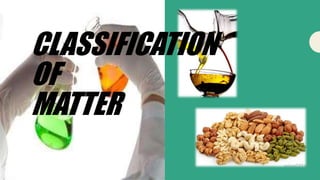
Classification of Matter (General Chemistry)
- 2. 1. Differentiate between homogeneous and heterogeneous mixtures; 2. Apply simple separation techniques such as distillation and chromatography; 3. Differentiate between pure substances and mixtures; 4. Differentiate between elements and compounds; and 5. Describe separation techniques for mixtures and compounds.
- 3. Halo-halo (from “halo” = mix) is one of the favorite Filipino desserts. It is a mixture of sweet preserved beans (red beans or chick peas), coconut meat (macapuno), jackfruit (langka), pounded dried rice (pinipig), sweet yam (ube), cream flan (leche flan), and shreds or sweetened plantain (saba), which is filled with crushed ice and milk, and topped with ice cream. Questions: 1. Given the ingredients of halo-halo, how can you differentiate one ingredient from another? 2. Do all the ingredients have the same properties? 3. When you mix the ingredients, do the ingredients react with one another? Or do the properties of each ingredient remain the same?
- 4. A mixture is a physical blend of two or more components; each of which retains its own identity and properties. The parts or components of a mixture are simply mixed together physically and can usually be separated. The properties of a mixture are a combination of the different properties of the components. For instance, the taste of the halo-halo is a combination of the tastes of the different ingredients.
- 5. • Mixtures can be classified as heterogenous mixtures or as homogeneous mixtures. • A mixture in which composition is not uniform throughout is a heterogeneous mixture.
- 6. • A homogeneous mixture is a mixture in which the composition throughout is uniform.
- 7. Take note that, a homogeneous mixture consists of a single phase while the heterogeneous mixture consists of two or more phases. Is an oil-water mixture a homogeneous mixture or a heterogeneous mixture? Why do you say so?
- 8. Differences in physical properties can be used to separate mixtures. There are various ways to separate a mixture depending on the properties of its components. The following are some separation techniques: Filtration is good for separating an insoluble solid from a liquid. For example, filtration can be done to separate sand (insoluble solid, which does not dissolve in water) from a mixture of sand and water mixture. Evaporation is good for separating a soluble solid from a liquid. For example, copper sulfate crystals can be separated from copper sulfate solution using evaporation. Take note that it is the water, not the solution, that evaporates.
- 9. Chromatography is good for separating mixtures of dissolved substances that have different colors, such as inks and plant dyes. Some colored substances dissolve in a certain solvent better than others do, so they travel further up the paper through adsorption and capillary action. Simple distillation is good for separating a volatile liquid from non-volatile substances in a solution. For example, water can be separated from the salt salty water by simple distillation.The water evaporates from the solution but is then cooled and condensed as it passes in a glass tube called the condenser.The condensed liquid is then collected as the distillate.The salt does not evaporate and so it stays behind as residue.
- 11. • A pure substance cannot be separated by physical means or any separation techniques. • It can be classified as elements or compounds. Element – is the simplest form of matter. Carbon (C) in charcoal and oxygen (O) are two of the more than 100 known elements. Compound – is a substance that contains two or more elements chemically combined in a fixed proportion. Hydrogen and oxygen in water are chemically combined, and in any amount of water sample, there are twice as many hydrogen atoms as oxygen atoms. This illustrates that the proportion of hydrogen atoms to oxygen atoms in water is fixed.
- 14. Separation techniques that are used to separate mixtures cannot be used to break compounds to simpler substances. Compounds are broken down into simpler compounds or elements by a chemical change. For example, water cannot be broken down to hydrogen and oxygen using any of the physical methods such as boiling. Instead, water can be subjected to electrolysis, an electricity-driven chemical reaction. In addition, table sugar or sucrose (C12H22O11) can be broken down by intense heat to yield the simpler substances which are carbon and water.
- 15. Assignment: In your house, examine common household materials like bleach, toothpaste, rubbing alcohol, shampoo, cooking oil, etc. Read the labels and identify the elements and compounds in the different materials. You may list 5 or more.Write it on a ½ crosswise. Materials Elements and Compounds
- 16. “The world is indeed a mixture of truth and make-believe. Discard the make- believe and take the truth.” - Ramakrishna
Editor's Notes
- Halo-halo is an example of a heterogeneous mixture, chicken macaroni soup (sopas) is also a heterogeneous mixture. A mixture in which composition is not uniform throughout is a heterogeneous mixture.
- Oil water is a Homogeneous mixture.
- Laboratory….